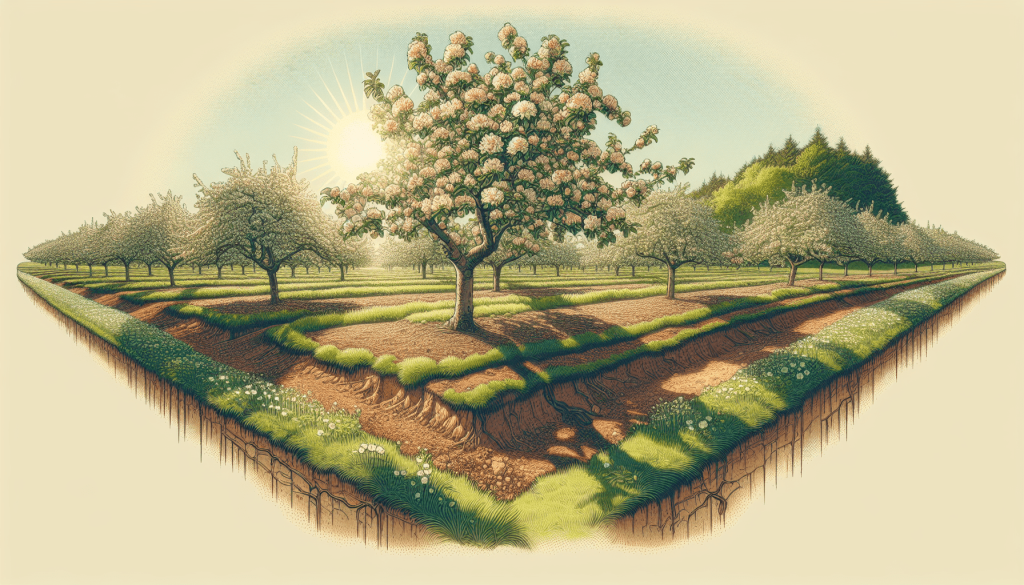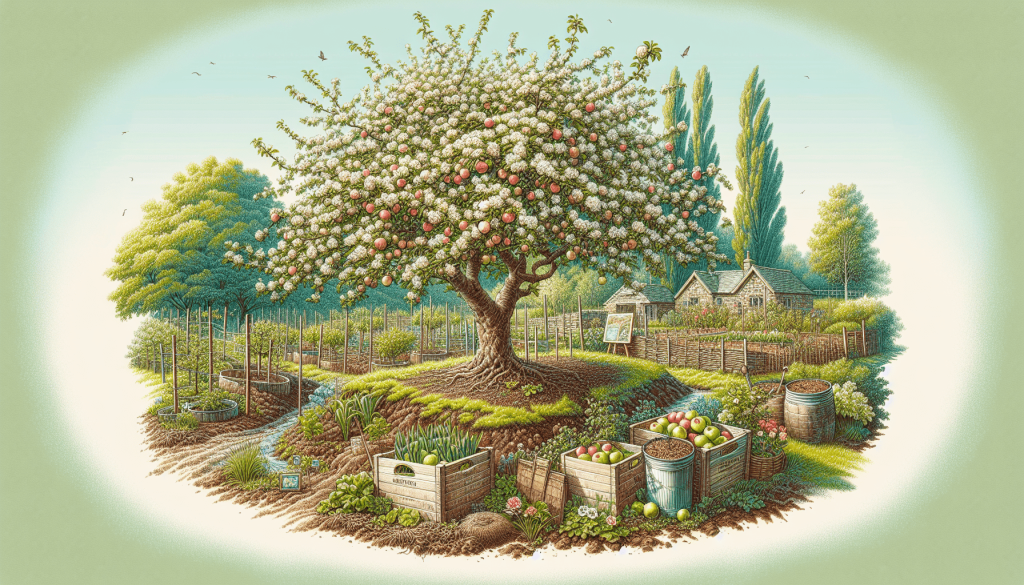So, you’ve decided to embark on the journey of starting an organic orchard in the UK? Congratulations! With its fertile soil, temperate climate, and growing demand for organic produce, the UK is the perfect place for cultivating your own orchard. But before you roll up your sleeves and grab your gardening tools, it’s essential to understand the steps involved in establishing your organic orchard. From selecting the right location to choosing the proper tree varieties, this article will guide you through the process of creating a thriving and sustainable orchard that will bear fruit for years to come.
Table of Contents
TogglePlanning and Research
Selecting the Right Location
When starting an organic orchard in the UK, one of the first steps is selecting the right location. It is crucial to choose a site that receives adequate sunlight and has well-drained soil. Fruit trees thrive in areas with full sun exposure for at least six hours a day, so it’s important to avoid shady or excessively windy locations. Additionally, considering factors such as proximity to markets and access to water sources can contribute to the success of your orchard.
Acquiring Land or Leasing
After identifying the ideal location, the next step is acquiring the land for your organic orchard. Depending on your circumstances and resources, you can choose to purchase the land or lease it. Owning the land provides security and flexibility in the long term, while leasing can be a more affordable option for those starting out. Whichever option you choose, it is important to ensure that the land meets legal and regulatory requirements for agricultural use.
Identifying Suitable Varieties of Fruit Trees
Before planting your orchard, it is essential to identify suitable varieties of fruit trees that are well-suited to the UK climate and market demands. Consider factors such as disease resistance, flavor, and yield when selecting your fruit tree varieties. Conduct thorough research to gather information on different varieties and consult local experts, such as agricultural extension offices or nurseries, for guidance on the best choices for your specific region.
Understanding Local Laws and Regulations
Complying with local laws and regulations is fundamental when starting an organic orchard in the UK. Familiarize yourself with organic certification requirements, zoning regulations, and any other permits or licenses that may be necessary for operating an orchard. It is also important to stay informed about any changes or updates in agricultural regulations to ensure your orchard remains in compliance with all legal obligations.
Soil Preparation
Testing the Soil
Before planting your fruit trees, it is crucial to test the soil to assess its composition and fertility. Soil testing provides valuable insights into the nutrient levels, pH balance, and organic matter content of the soil. This information is essential for determining the necessary amendments to optimize soil health and productivity. Soil testing kits are available from agricultural extension offices or private laboratories, and the results will guide your soil improvement efforts.
Improving Soil Fertility
Once you have received the results from your soil test, you can take steps to improve soil fertility in preparation for planting. Organic matter, such as compost or well-rotted manure, can be incorporated into the soil to enhance its structure and nutrient content. Additionally, organic fertilizers that are approved for organic farming can be used to provide essential nutrients to the soil. This process of improving soil fertility ensures that your fruit trees have the necessary nutrients for healthy growth and productivity.
Organic Soil Amendments
In organic orchards, it is important to prioritize the use of organic soil amendments. Organic matter, such as compost or green manure, not only improves soil fertility but also enhances its water-holding capacity and overall health. Utilizing these organic amendments helps maintain the organic integrity of your orchard and promotes a sustainable ecosystem that supports beneficial microorganisms and earthworm populations.
Implementing Crop Rotation
Implementing crop rotation is an effective practice for maintaining soil health and preventing the buildup of pests and diseases. By rotating different fruit tree varieties or intercropping with other crops, you can disrupt pest cycles and maintain a balanced soil ecosystem. Crop rotation also helps prevent nutrient depletion in the soil by alternating the nutrient requirements of different crops. Plan your orchard layout and crop rotation schedule to maximize the long-term productivity and sustainability of your organic orchard.
Planting
Choosing the Best Time for Planting
Selecting the optimal time for planting fruit trees is crucial to ensure their successful establishment. Generally, bare-root fruit trees should be planted during the dormant season, typically in late autumn or early spring, depending on the specific variety and climate in your region. Container-grown trees can be planted at any time of the year, as long as the soil is workable and not waterlogged. Consider local climate conditions and frost dates when deciding on the best time for planting in your area.
Spacing and Layout
Proper spacing and layout of fruit trees are essential for their healthy development and efficient orchard management. Adequate spacing between trees allows room for their canopy growth and enables access for maintenance tasks such as pruning, thinning, and harvesting. The recommended spacing varies depending on the specific fruit tree variety and rootstock, but a general guideline for apple and pear trees is around 12-15 feet between trees and 18-20 feet between rows.
Digging the Holes
When planting fruit trees, it is important to dig the holes deep enough to accommodate the roots without bending or crowding them. The size of the planting hole should be wide enough to allow for root expansion and incorporation of organic matter or compost. Gently spread out the root system in the planting hole and backfill with the amended soil, ensuring that the tree is planted at the appropriate depth and the soil is firmly packed to eliminate any air pockets around the roots.
Installing Support Structures
Some fruit trees may require support structures to ensure their stability and proper growth. While many modern fruit tree varieties are bred for dwarfing rootstocks and don’t require support, others, such as some apple or pear trees, may benefit from trellises or stakes. Install these support structures at the time of planting or shortly after to avoid damaging the tree’s roots. Properly supporting the trees early on will help them establish a strong framework and promote healthy growth in the long term.
Irrigation and Water Management
Installing Irrigation Systems
Establishing an efficient irrigation system is essential to ensure the water needs of your fruit trees are properly met. Installing irrigation systems, such as drip irrigation or micro-sprinklers, helps conserve water and delivers it directly to the root zone. Avoid overhead irrigation methods as they can lead to increased disease risks and inefficient water usage. Consult irrigation experts or agricultural extension offices for guidance on the best irrigation system for your specific orchard and soil conditions.
Watering Techniques
Proper watering techniques play a crucial role in the health and productivity of fruit trees. Young trees require more frequent watering to support their establishment, while mature trees have deeper root systems and can tolerate longer intervals between waterings. Water deeply and thoroughly, ensuring the soil is moistened to the root depth. Avoid overwatering or creating waterlogged conditions, as excessive moisture can lead to root rot and other detrimental effects on tree health.
Mulching to Conserve Moisture
Mulching is an effective practice for conserving moisture in the soil and reducing weed competition around fruit trees. Organic mulch materials, such as wood chips or straw, help retain soil moisture by reducing evaporation and regulating soil temperature. Apply a layer of mulch around the base of the tree, leaving a small gap around the trunk to avoid potential issues with moisture trapped against the bark. Mulching also contributes to soil health by gradually decomposing and adding organic matter to the soil.
Monitoring and Adapting to Water Needs
Monitoring the water needs of your fruit trees is crucial to ensure they receive adequate moisture without overwatering. Regularly check the soil moisture levels by observing the appearance and feel of the soil. Use a moisture meter or insert a finger into the soil to determine its moisture content at different depths. Adjust your watering schedule accordingly, taking into consideration weather conditions, tree maturity, and any signs of water stress, such as wilting leaves or reduced fruit production.
Pest and Disease Management
Identifying Common Orchard Pests and Diseases
In an organic orchard, it is important to be proactive in identifying and managing common pests and diseases that may affect your fruit trees. Familiarize yourself with the signs and symptoms of prevalent orchard pests, such as aphids, codling moth, or apple scab. Additionally, learn about common diseases like fire blight or powdery mildew that may impact the health and productivity of your trees. Regular scouting and observation can help detect early signs of pest or disease infestations and allow for timely intervention.
Cultural Practices for Pest Prevention
Implementing cultural practices for pest prevention is an integral part of organic orchard management. Practices such as proper sanitation, pruning to improve airflow, and removing fallen leaves or fruit can help reduce pest habitat and limit the spread of diseases. Maintaining a healthy orchard ecosystem by promoting beneficial insects, birds, or other natural predators can also contribute to natural pest control. By creating a supportive environment for beneficial organisms, you can minimize the reliance on chemical interventions.
Organic Pest Control Methods
In organic orchards, the use of chemical pesticides is prohibited. Therefore, it is important to rely on organic pest control methods to manage pests effectively. This includes using insect traps, pheromone-based mating disruption, or physical barriers to prevent pests from reaching the fruit. Additionally, introducing beneficial insects, such as ladybugs or lacewings, can help control pest populations naturally. Predatory nematodes or microbial insecticides can also be used as organic alternatives for targeted pest control.
Monitoring and Early Intervention
Regular monitoring of your orchard is crucial for identifying pest or disease issues early on and taking appropriate action. Perform routine inspections of your trees, foliage, and fruits to observe any signs of pests, diseases, or stress. Promptly address any issues by implementing appropriate control measures, such as handpicking pests, pruning infected branches, or applying organic-approved treatments. Early intervention is key to preventing the spread of pests or diseases and minimizing potential damage to your crop.
Fruit Tree Pruning and Training
Understanding Pruning Principles
Pruning is an essential practice for maintaining the health, structure, and productivity of fruit trees. Understanding the basic principles of pruning is important to ensure that you make informed decision when it comes to shaping and training your trees. Pruning helps remove dead or diseased wood, improves airflow within the canopy, and promotes better light penetration for improved fruit production. Different fruit tree species and varieties have specific pruning requirements, so consult reliable resources or local experts for guidance on appropriate techniques.
Pruning Techniques for Fruit Trees
Pruning techniques can vary depending on the type of fruit tree and the desired growth habit. Some common pruning techniques include thinning cuts, heading cuts, or rejuvenation pruning. Thinning cuts help reduce overcrowding within the canopy, heading cuts promote branching and shape control, while rejuvenation pruning rejuvenates older trees by removing older branches. It is important to use sharp pruning tools and make clean cuts to minimize the risk of disease entry. Proper technique and timing are crucial for successful pruning and optimal growth of your fruit trees.
Training Young Trees for Optimal Growth
Training young fruit trees from the early stages of growth is essential to establish a strong framework and promote healthy development. This involves shaping the tree’s structure by selecting and retaining the main central leader or central scaffold branches. Employ techniques such as pruning to an outward-facing bud, removing competing branches, or staking to ensure the tree’s proper form. Training young trees not only enhances their aesthetics but also facilitates future management tasks, such as harvesting or pest control.
Renovation Pruning for Existing Trees
Renovation pruning is a technique used to rejuvenate older or neglected fruit trees that require corrective pruning. This practice involves removing excess or overcrowded branches, reducing the overall size of the tree, and promoting new growth. Renovation pruning can help improve fruit quality and increase productivity by invigorating the tree’s growth and allowing better light penetration into the canopy. However, it is important to be cautious and gradually renovate the tree over a few years to avoid overly stressing it.
Fruit Thinning and Harvesting
Importance of Fruit Thinning
Fruit thinning is a crucial practice for maintaining the quality and size of your fruit crop. Thinning allows for adequate spacing between fruits on the tree, reducing competition and preventing overcrowding. Removing excess fruit also helps prevent branches from breaking under the weight of the crop and promotes better airflow within the canopy, reducing the risk of diseases. Thinning improves fruit size, color, and flavor, ensuring that the remaining fruits receive sufficient nutrients for optimal development.
Methods for Fruit Thinning
There are several methods for fruit thinning, including hand thinning and chemical thinning. Hand thinning involves manually removing excess fruits by hand or using specialized tools such as thinning shears. This method allows for precise control and can be particularly effective for trees with heavy fruit set. Chemical thinning involves applying specific plant hormones or chemicals to induce fruit drop. Careful consideration of the tree’s health, vigor, and desired fruit load is essential when choosing the appropriate thinning method for your orchard.
Determining the Right Time to Harvest
Determining the right time to harvest your fruit is critical for optimal flavor, ripeness, and storage life. Different fruit varieties have specific maturity indicators, such as color change, firmness, or sugar content, which can help gauge their readiness for harvest. It is essential to closely monitor your fruit trees, perform regular taste tests, and consult variety-specific guidelines for harvesting. Harvesting too early or too late can result in reduced taste quality, texture issues, or short shelf life, impacting the overall value of your fruit crop.
Harvesting and Handling Techniques
Proper harvesting and handling techniques are important to minimize fruit damage and ensure post-harvest quality. Use sharp pruning shears or hand clippers to carefully remove fruits from the trees, avoiding unnecessary bruising or tearing. Handle the fruit gently to prevent any unnecessary stress or impact on the fruit’s integrity. Sort and grade the harvested fruit based on size and quality to meet market standards or personal preferences. Promptly move the harvested fruit to cool storage or packaging areas to maintain freshness and extend shelf life.
Soil and Tree Health Monitoring
Regular Soil Testing
Regular soil testing is crucial for monitoring and maintaining the health and fertility of your orchard soil. Conducting routine soil tests can help determine nutrient levels, pH balance, and any potential imbalances or deficiencies. This information allows you to adjust your soil management practices accordingly, such as modifying fertilization or organic amendments. Regular soil testing also provides a historical record that helps you track changes and make informed decisions for ongoing soil health improvement and tree productivity.
Tree Health Inspection
Regular tree health inspections are essential for early detection of any issues or stress that may affect your fruit trees’ growth and productivity. Regularly inspect your trees for signs of pests, diseases, nutrient deficiencies, or physical damage. Look for symptoms such as wilting leaves, discoloration, unusual growth patterns, or pest presence. Promptly address any tree health issues through proper identification and treatment, ensuring that your trees receive the care they need to thrive and produce high-quality fruit.
Identifying Nutrient Deficiencies
Nutrient deficiencies can negatively impact the health and productivity of fruit trees. Familiarize yourself with common nutrient deficiencies and their associated symptoms, such as yellowing leaves, stunted growth, or poor fruit quality. Visual observations and leaf tissue analysis can help identify specific nutrient deficiencies, allowing you to take appropriate corrective actions. Addressing nutrient deficiencies through targeted fertilization or amendments ensures that your fruit trees have the necessary nutritional support for optimal growth and fruit production.
Addressing Soil and Tree Health Issues
When soil or tree health issues arise, it is important to take prompt action to address and resolve them. Depending on the specific issue, this may involve adjusting irrigation practices, implementing pest control measures, or applying appropriate organic amendments. Consult experts or local agricultural extension offices for guidance on specific remedies or treatments for your area and orchard type. Regular monitoring and proactive management practices help maintain a healthy ecosystem and ensure the long-term success of your organic orchard.
Marketing and Selling Organic Produce
Developing a Marketing Strategy
Once your organic orchard is producing fruit, it is important to develop a marketing strategy to effectively reach consumers and sell your produce. This involves understanding your target market and identifying various marketing channels, such as farmers’ markets, local grocery stores, community-supported agriculture (CSA) programs, or online platforms. Consider factors such as pricing, packaging, branding, and promotional activities to differentiate your organic produce and attract customers.
Certifying Organic Products
To market your fruit as organic, it is essential to obtain organic certification. Certification requires compliance with specific regulations and standards set by organic certification bodies. Engage with a recognized certification agency that verifies your adherence to organic practices and grant the necessary certification. Clearly highlight your organic certification on product labels and marketing materials to build consumer trust and ensure compliance with organic industry standards.
Creating Brand Awareness
Building brand awareness is key to establishing a strong presence in the market and distinguishing your organic produce from competitors. Develop a distinctive brand name, logo, and packaging design that reflect the values and qualities of your orchard and its organic produce. Engage in social media marketing, website development, and community outreach to enhance brand visibility and establish connections with potential customers. Cultivating a positive brand image through consistent quality, ethics, and customer service helps to build long-term relationships with consumers.
Building Relationships with Customers
Fostering relationships with your customers is essential for maintaining their loyalty and repeat business. Engage with customers at farmers’ markets, through online platforms, or via direct sales channels to establish a personal connection and understand their preferences and feedback. Respond to customer inquiries and concerns promptly, providing exemplary customer service. Offer educational resources or workshops to enhance customer knowledge and appreciation of organic farming practices. Building trust and strong relationships with your customers will contribute to the long-term success of your organic orchard.
Continued Maintenance and Care
Weeding and Mulching
Continued maintenance and care of your orchard ensure its ongoing health and productivity. Regularly remove weeds to prevent competition for nutrients and water with your fruit trees. Cultivate the soil around the trees to suppress weed growth and to ensure proper air and water circulation. Mulch the base of the trees with organic materials to suppress further weed growth and conserve soil moisture. Ongoing weeding and mulching practices help maintain a clean and healthy orchard environment for your fruit trees.
Fertilizing Fruit Trees
Proper fertilization is an essential aspect of ongoing orchard care. Organic fertilizers, such as compost or well-rotted manure, provide essential nutrients to your fruit trees while also enriching the soil. Apply organic fertilizers in early spring or late autumn, following the recommended application rates for your specific fruit tree varieties. Consider regular foliar feeding as a supplemental nutrient source throughout the growing season. Proper fertilization supports healthy growth, improves fruit quality, and helps maintain the overall vigor of your orchard.
Pruning and Training Mature Trees
Mature fruit trees require ongoing pruning and training to maintain their structure, health, and productivity. Regularly inspect the trees for dead, damaged, or crossed branches and remove them to improve airflow and reduce disease risks. Conduct annual pruning to maintain the desired shape, remove excess growth, and rejuvenate older branches. Pay attention to the specific pruning requirements of your fruit tree varieties and adjust your pruning strategies as the trees mature. Proper maintenance pruning helps optimize fruit yield and quality.
Monitoring and Adjusting Orchard Management
Continued monitoring and adjustment of your orchard management practices are crucial for addressing changing conditions and optimizing your fruit production. Regularly observe the growth, health, and productivity of your fruit trees, and make any necessary adjustments to your irrigation, fertilization, or pest management practices. Stay informed about new developments in organic farming techniques, research, and industry best practices. Evaluating and adapting your orchard management strategies ensures that you can effectively respond to changes and maintain the long-term success of your organic orchard in the UK.
In conclusion, starting an organic orchard in the UK involves careful planning, research, and ongoing maintenance. It begins with selecting the right location, acquiring land or leasing, identifying suitable fruit tree varieties, and understanding local laws and regulations. Soil preparation, including soil testing, improving fertility, organic soil amendments, and implementing crop rotation, is crucial for establishing a healthy foundation. Planting involves choosing the best time, spacing and layout, digging proper holes, and installing support structures. Irrigation and water management, pest and disease management, fruit tree pruning and training, fruit thinning and harvesting, soil and tree health monitoring, marketing and selling organic produce, as well as continued maintenance and care, are all vital components of running a successful organic orchard. By following these steps and consistently applying organic practices, you can embark on a rewarding journey of cultivating delicious organic fruit while contributing to a sustainable and eco-friendly agriculture industry in the UK.








